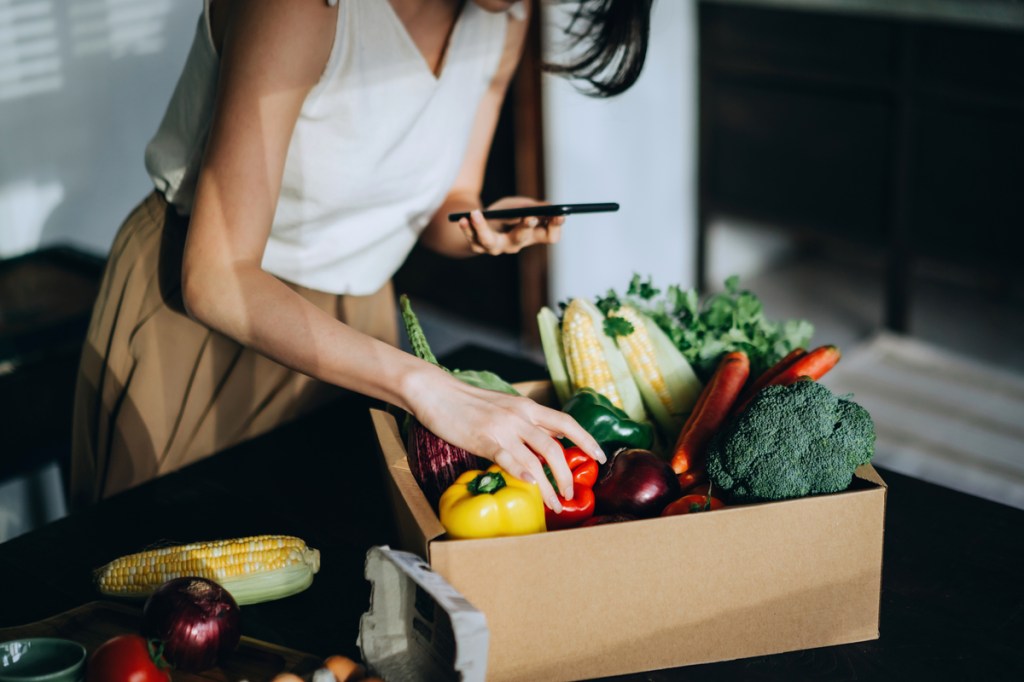The New Grocery Normal: Fast, Free, and Frictionless
Amazon is setting a new standard for grocery convenience. Tens of millions of Prime members can now order perishables like strawberries, dairy, and fresh-baked goods alongside electronics, apparel, and household staples and have them delivered in just hours. Orders over $25 come with free delivery, erasing one of the last barriers to frequent online grocery use.
What makes this expansion so disruptive is the way it blurs the lines between traditional grocery and e-commerce. Consumers are no longer constrained by store hours or physical proximity. They can shop for apples and AirPods in the same transaction, with the same delivery promise.
This shift is powered by:
- Unified shopping experiences: Amazon’s platform allows consumers to seamlessly mix perishables with electronics, apparel, and more.
- AI-driven personalization: Product recommendations are tailored to individual preferences, browsing history, and even local weather patterns
- Operational scale: Amazon’s fulfillment infrastructure—including regional hubs and insulated packaging protocols—enables rapid delivery without compromising freshness.
What are the industry experts saying about Amazon’s grocery expansion?
Retail in the Age of Instant Gratification
Traditional grocery chains are now in a dual fight: maintaining in-store traffic while rapidly scaling digital capabilities. Amazon’s bundled cart model, where shoppers add apples and AirPods together, threatens to shift share from brick-and-mortar to online-first platforms.
And the stakes are high. Over the past 52 weeks, U.S. shoppers allocated 53% of their in-store spending to food, yet only 21% of their online dollars went toward the same category. Amazon’s move shows a sharp focus on this lucrative growth opportunity.
To compete, retailers must respond with urgency. The playbook includes:
- Omnichannel Capabilities Are No Longer Optional
Same-day delivery, curbside pickup, and real-time inventory visibility are now table stakes. Consumers expect flexibility and speed, and retailers who can’t deliver risk irrelevance.
- Loyalty Must be Reimagined
Legacy loyalty programs focused on points and discounts are losing traction. Today’s consumers want personalized rewards, seamless digital integration, and value beyond price. Retailers must invest in platforms that deliver contextual offers and real-time engagement.
- Margin Protection Required Strategic Innovation
Competing with Amazon’s pricing and delivery model is costly. Retailers must explore strategic partnerships, invest in automation, and optimize supply chains to protect profitability.
CPG Brands: When Shelf Space Goes Digital
For CPG brands, Amazon’s grocery expansion opens up new digital shelf opportunities across thousands of zip codes. Perishable and Fresh categories—once limited by geography and logistics—can now be digitally merchandised nationwide.
But it’s not just about selling more; it’s about selling smarter. Brands that embrace digital shelf strategies will be better positioned to capture share, build loyalty, and drive growth.
Here’s how leading brands are capitalizing:
- Precision Targeting at Zip-Code Level
Amazon’s data-rich environment enables brands to tailor promotions, pricing, and product bundles to hyper-local demand. A yogurt brand, for example, can target health-conscious consumers in Boston with same-day delivery and personalized offers—something that was logistically impossible just a few years ago.
- Accelerated Speed-to-Market
New product launches can be tested and scaled faster, with real-time feedback loops. Brands can monitor performance, adjust pricing, and iterate packaging based on actual consumer behavior—not just retailer feedback.
- AI-Driven Personalization
Amazon’s recommendation engines surface products in contextually relevant moments—whether it’s suggesting granola with almond milk or bundling cleaning supplies with pet food. CPG brands that integrate with these engines can dramatically increase visibility and conversion.
Fresh Suppliers: Scaling Speed Without Sacrificing Quality
Fresh produce and perishable suppliers stand to gain from the volume lift Amazon’s expansion will drive, but speed must not come at the cost of freshness. Amazon’s six-point freshness checks and insulated packaging protocols are now the industry benchmark.
The opportunity is massive, but so is the risk. According to NIQ’s Top US Retailers Index, among the top ten online super categories, Meat, Vegetables, and Cheese all saw more than 15% YoY Growth. As Amazon expands in pursuit of similar growth, Fresh suppliers stand to make major gains.
But for these categories, freshness is the top priority, so suppliers must deliver excellence at scale. To succeed, suppliers must invest in:
- Agile Logistics and Cold Chain Infrastructure
Speed is critical, but so is temperature control. Regional distribution hubs, real-time tracking, and insulated packaging are essential to maintaining freshness and meeting Amazon’s standards.
- Consistent Quality Across Markets
With perishables, consumer trust hinges on consistency. A bruised apple or wilted lettuce can erode brand equity in seconds. Suppliers must implement rigorous quality control and standardized handling procedures.
- Collaborative Forecasting and Data Sharing
Demand for fresh products can spike unexpectedly—due to weather, promotions, or local events. Sharing data across the supply chain helps anticipate these spikes, reduce waste, and ensure availability.
What’s Next: Future-Proofing in a Fragmented Landscape
Amazon’s grocery expansion is a bellwether for broader industry transformation. As convenience becomes the new currency, brands must rethink how they engage, deliver, and innovate.
At NIQ, we see this as a pivotal moment to:
- Harness full-view data across channels and categories to understand consumer behavior holistically.
- Activate AI-driven insights to anticipate needs, personalize experiences, and optimize performance.
- Build resilient strategies that adapt to shifting fulfillment models, regulatory environments, and consumer expectations.
The future of grocery is not just fast, it’s smart, scalable, and deeply connected. Brands that embrace this reality will not only survive, they’ll lead.

Are You Ready to Compete in the New Grocery Economy?
NIQ helps CPG brands and retailers unlock data-driven growth in a world where speed and personalization define success. From omnichannel strategy to AI-powered insights, we’re here to help you thrive in Amazon’s new grocery reality.
Let’s talk about how your business can stay ahead.




